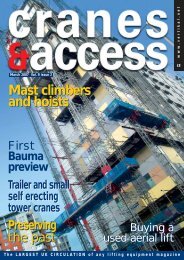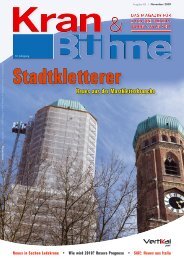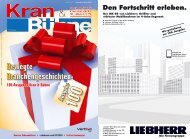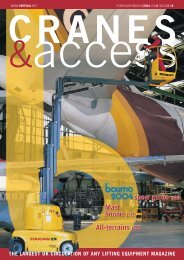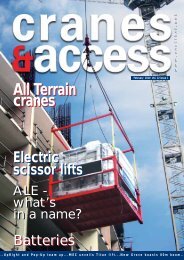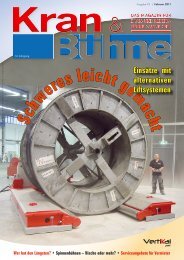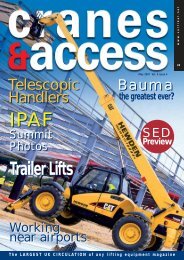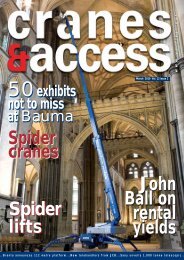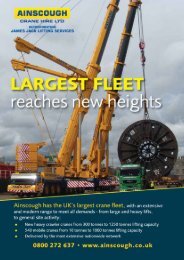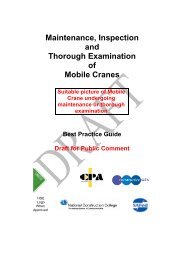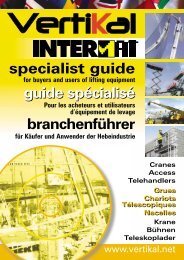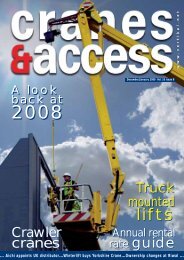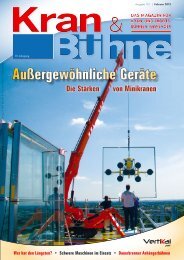Bauma Bauma
Bauma Bauma
Bauma Bauma
You also want an ePaper? Increase the reach of your titles
YUMPU automatically turns print PDFs into web optimized ePapers that Google loves.
straight booms c&a<br />
When it comes to straight booms<br />
however, regular users have even<br />
eschewed regular jibs in the past,<br />
preferring rigidity and ruggedness<br />
over the additional reach potential<br />
of a jib. Users have however<br />
become more familiar with the<br />
benefits of articulating jibs and<br />
today they are just about standard<br />
equipment on straight booms.<br />
Rotating jibs also now beginning to<br />
creep into use with both JLG and<br />
Haulotte fitting them as standard<br />
on their top of the line 135ft models.<br />
The concept is likely to become<br />
increasingly available on smaller<br />
units as time goes by. Whether it<br />
will become popular or not remains<br />
to be seen, one assumes that given<br />
rigidity and complexity issues the<br />
concept will not suit the rough and<br />
tumble conditions of steel erection<br />
or shipyard work.<br />
Basket case<br />
A look at spare parts usage on straight<br />
booms flashes up an interesting<br />
fact, straight booms, particularly 40<br />
and 60ft models seem to consume<br />
baskets. Yes baskets - platforms -<br />
cages - no matter what you call<br />
them they seem to last no time on<br />
a straight boom. A visit to a typical<br />
steel erection job provides the<br />
answer behind this oddity, trades<br />
such as this use the boom not only<br />
to reach the work but also to push,<br />
shove the steelwork into place and<br />
to help hold it steady while welding<br />
or bolting it in place. You might ask<br />
why manufacturers don't beef up<br />
this part of the lift to cope with this<br />
somewhat dubious practice? The<br />
main answer is that this would<br />
simple transfer the abuse into other<br />
components further down the lift<br />
mechanism. Building the entire<br />
machine to cope with this abuse<br />
would create a prohibitively priced<br />
22 cranes & access April 2007<br />
The Haulotte H43TPX<br />
demonstrates its rotating jib<br />
machine. So instead the users that<br />
follow this practice almost see<br />
the basket as a consumable. The<br />
challenge then for manufacturers<br />
is to crate a basket that can be<br />
quickly replaced or repaired and<br />
that does not cost the earth.<br />
JLG has done a good deal of work<br />
on some models to modularise the<br />
cage so that separate sections can<br />
be replaced rather than the whole.<br />
Genie on the other hand has<br />
focused on cost and offers an<br />
attractive price on replacement<br />
platforms that can be rapidly<br />
changed over.<br />
Some rental companies keep<br />
abused and repaired platforms in<br />
stock to fit for abusive applications.<br />
Trades such as Steel erection treat<br />
boom baskets as a consumable.<br />
Sometimes only a tracked boom will do<br />
When the going gets rough<br />
All of the straight booms on the<br />
market today feature or offer four<br />
wheel drive with differential locks<br />
or hydraulic flow dividers that<br />
ensure constant all wheel drive,<br />
enhancing the machine's performance<br />
in rough muddy ground.<br />
If buying a boom that offers four<br />
wheel drive as an option make sure<br />
that you specify it. In Europe most<br />
manufacturers do not import or<br />
offer two wheel drive straight<br />
booms except by non cancellable<br />
order. Do not be tempted to save<br />
money by ordering a two wheel<br />
drive boom - it is a false economy.<br />
Four wheel drive not only enhances<br />
off road performance, but in most<br />
cases it also dramatically improves<br />
gradeability, which is essential if<br />
you are using the boom on slopes<br />
or regularly loading it onto<br />
transport. Over and above these<br />
practical reasons, when it comes<br />
time to sell your boom on, a two<br />
wheel drive straight boom is about<br />
as attractive as roast pork in a<br />
mosque to used boom buyers.<br />
If you are planning to use a boom<br />
in soft or slippery conditions,<br />
attention should also be directed<br />
towards the tyres. Boom lifts are<br />
increasingly being fitted with low<br />
profile foam filled tyres. These are<br />
very attractive in many, if not most<br />
applications. They use less foam<br />
than bigger tyres, are more rigid<br />
and thus provide more stability and<br />
should the rubber shred, the big<br />
steel rims will keep the boom<br />
stable and allow easy recovery.<br />
However, when it comes to the<br />
worst conditions, the lack of tyre<br />
side wall flex and smaller lugs,<br />
mean that the tyres quickly fill up<br />
with mud turning them into ‘slicks’.<br />
If heavy mud is to be a regular<br />
challenge then select a machine<br />
or a tyre option with the largest<br />
diameter, high profile side walls<br />
and deep lugs. In the extreme this<br />
might be a key criteria in your<br />
choice of machine.<br />
For the worst ground<br />
a large tyre with deep<br />
lugs can help<br />
When it is really tough<br />
There are times when the conditions<br />
are so bad that wheeled machines<br />
simply will not hack it. In such<br />
cases there are a couple of options.<br />
JLG and Aichi both produce standard<br />
straight boom lifts on self propelled<br />
tracked chassis. For more details<br />
on this type of boom see<br />
Cranes&Access October 2006.<br />
The Loegering crawler units can be<br />
retrofitted to a boom lift and then<br />
converted back again.<br />
An alternative to buying a full<br />
crawler mounted boom lift is to use<br />
temporary tracks. A number of<br />
companies produce web type<br />
tracks that fit over the tyres either<br />
between the existing wheels or<br />
between the rear axle and a spring<br />
loaded jockey wheel in between the<br />
two to create a half track.<br />
One company that offers these<br />
solutions, Loegering, has also<br />
introduced a third possibility - separate<br />
triangular crawler units that can be<br />
exchanged for the regular wheels<br />
on a boom lift to create a crawler<br />
mounted lift that can be easily<br />
converted back into a wheeled<br />
machine when the job is over.<br />
A boom for industry, the unusual 14m<br />
Kreitzler KIB 24/162T straight boom<br />
offers four wheel over centre steering<br />
and 500kg lift capacity.



